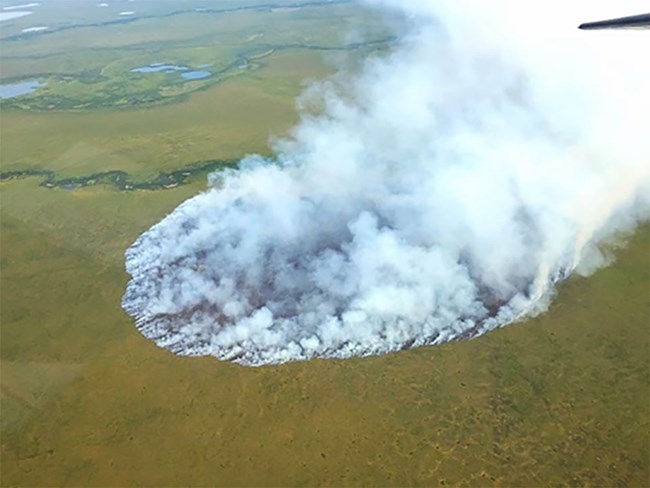Last updated: February 18, 2021
Article
In Alaskan Arctic, tundra wildfire drives large loss of nutrients from terrestrial to aquatic ecosystems

Bureau of Land Management, Alaska Fire Service
Climate change is increasing the frequency and size of wildfires in the Arctic. Disturbance from wildfire in the northern permafrost region can alter vegetation, accelerate permafrost thaw, and change the climate by driving carbon exchange with the atmosphere. Most research on wildfire in Alaska has focused on the boreal forest region, where fire is an important component of ecosystem processes and landscape history. Little is known about the effects of wildfires on tundra biomes, particularly how they effect linkages across terrestrial and aquatic ecosystems.
In this study, we examined the effects of tundra wildfire on the transfer of nutrients like nitrogen and phosphorus from burned terrain to stream and river networks. Stream water samples were collected and analyzed from burned and unburned watersheds in and around the Anaktuvuk River fire, a 10-year-old fire scar on the North Slope of Alaska. The wildfire dramatically reduced soil carbon and nitrogen stocks, yet the transport of organic nitrogen was nearly 60% higher in burned watersheds compared to unburned watersheds. Organic phosphorus and sulfur followed similar patterns as nitrogen across burned and unburned watersheds. Further analyses indicated that this elevated transfer of organic nutrients to streams and rivers following fire was likely due to regrowth of vegetation. Plants appear to take up nutrients from thawing permafrost following fire. These nutrients can then be released from plants and transported by groundwater flow and runoff to streams. The loss of nutrients from terrestrial ecosystems following fire may alter vegetation trajectories and the capacity of tundra ecosystems to take up carbon from the atmosphere.
Acknowledgement
This work was conducted in part through a grant through the National Science Foundation’s Office of Polar Programs in collaboration with Brigham Young University, Michigan State University, the University of Vermont, and the National Park Service.
Tundra wildfire triggers sustained lateral nutrient loss in Alaskan Arctic
Abstract
Climate change is creating widespread ecosystem disturbance across the permafrost zone, including a rapid increase in the extent and severity of tundra wildfire. The expansion of this previously rare disturbance has unknown consequences for lateral nutrient flux from terrestrial to aquatic environments. Lateral loss of nutrients could reduce carbon uptake and slow recovery of already nutrient‐limited tundra ecosystems. To investigate the effects of tundra wildfire on lateral nutrient export, we analyzed water chemistry in and around the 10‐year‐old Anaktuvuk River fire scar in northern Alaska. We collected water samples from 21 burned and 21 unburned watersheds during snowmelt, at peak growing season, and after plant senescence in 2017 and 2018. After a decade of ecosystem recovery, aboveground biomass had recovered in burned watersheds, but overall carbon and nitrogen remained ~20% lower, and the active layer remained ~10% deeper. Despite lower organic matter stocks, dissolved organic nutrients were substantially elevated in burned watersheds, with higher flow‐weighted concentrations of organic carbon (25% higher), organic nitrogen (59% higher), organic phosphorus (65% higher), and organic sulfur (47% higher). Geochemical proxies indicated greater interaction with mineral soils in watersheds with surface subsidence, but optical analysis and isotopes suggested that recent plant growth, not mineral soil, was the main source of organic nutrients in burned watersheds. Burned and unburned watersheds had similar δ15N‐NO3−, indicating that exported nitrogen was of preburn origin (i.e., not recently fixed). Lateral nitrogen flux from burned watersheds was 2‐ to 10‐fold higher than rates of background nitrogen fixation and atmospheric deposition estimated in this area. These findings indicate that wildfire in Arctic tundra can destabilize nitrogen, phosphorus, and sulfur previously stored in permafrost via plant uptake and leaching. This plant‐mediated nutrient loss could exacerbate terrestrial nutrient limitation after disturbance or serve as an important nutrient release mechanism during succession.
Abbott, B. W., A. V. Rocha, A. Shogren, J. P. Zarnetske, F. Iannucci, W. B. Bowden, S. P. Bratsman, L. Patch, R. Watts, R. Fulweber, R. J. Frei, A. M. Huebner, S. M. Ludwig, G. T. Carling, and J. A. O’Donnell. 2021. Tundra wildfire triggers sustained lateral nutrient loss in Alaskan Arctic. Global Change Biology
